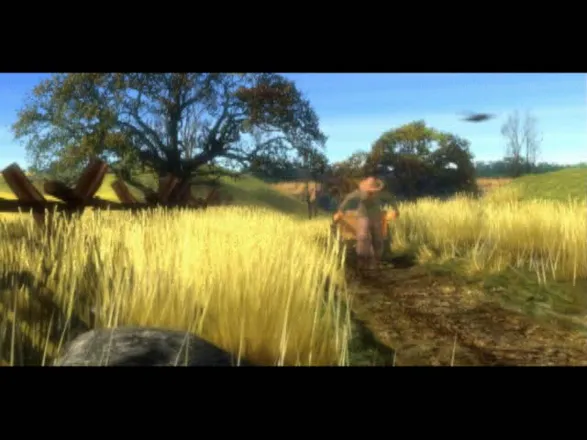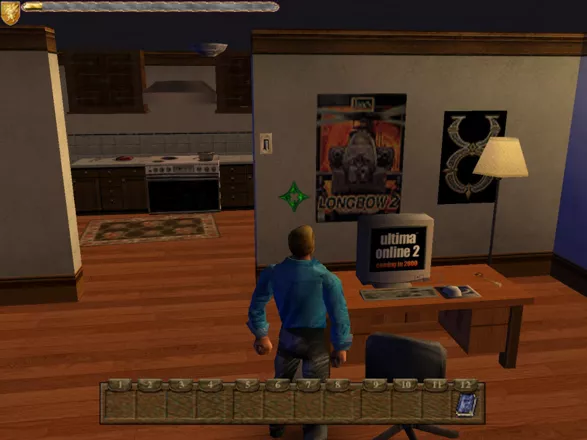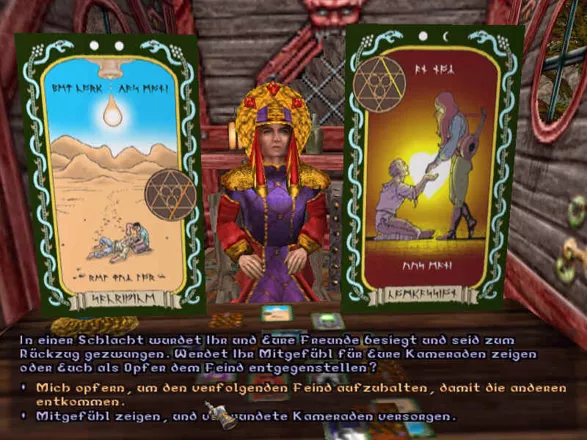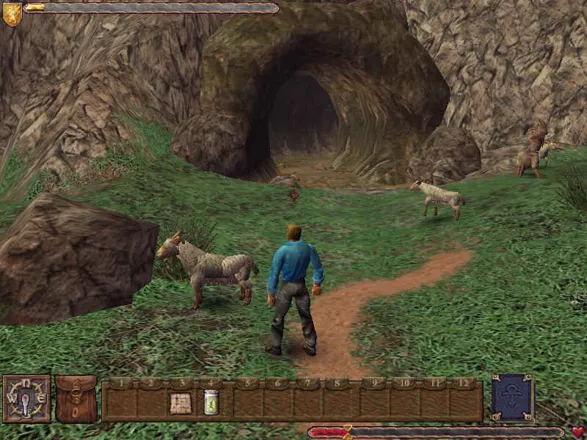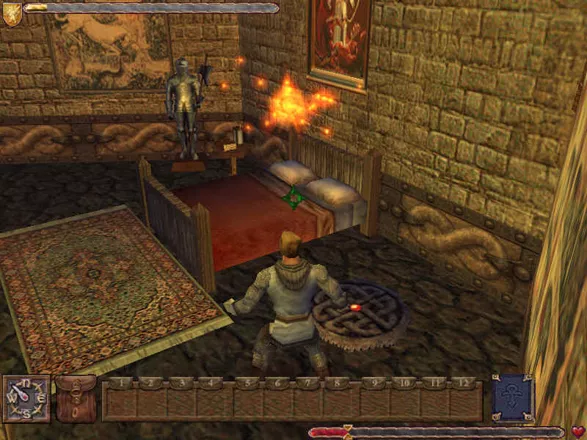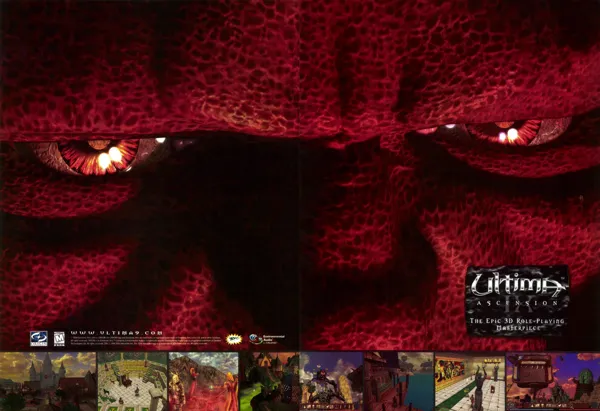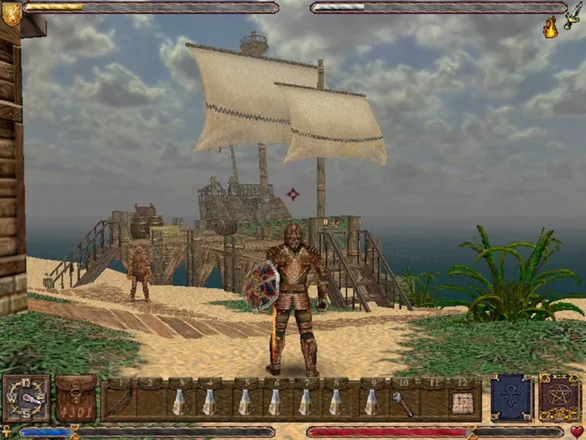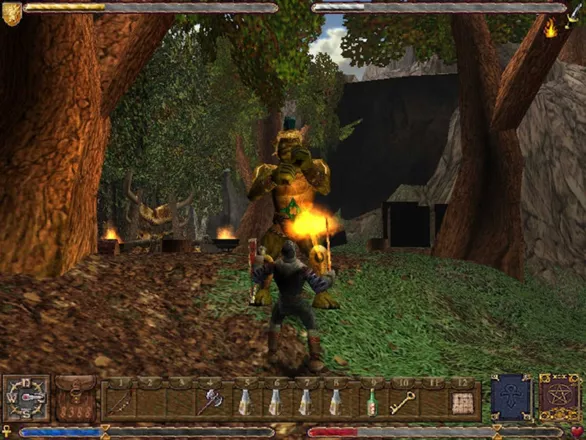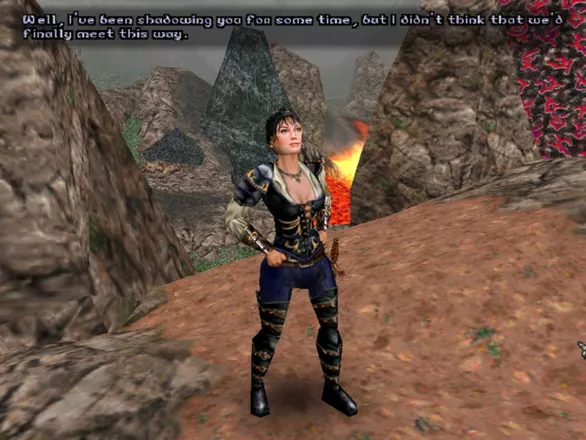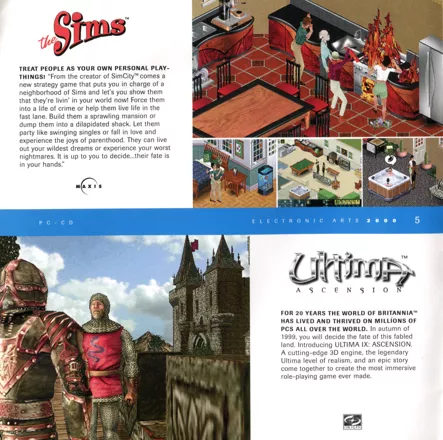Ultima IX: Ascension (1999) - MobyGames (original) (raw)
aka:Ultima 9,Ultima: Ascension
Moby ID: 779
- Overview
- Credits
- Reviews
- Covers
- Screenshots
- Videos
- Promos
- Trivia
- Specs
- Releases
- Patches
- Prices
- Forum
- Contribute
Moby Score
7.2
#10,808 of 25.5K
Critics
70%(38)
Players
(105)
Review Ranking
- #4,103 on Windows
Collected By
180 players
Note: We may earn an affiliate commission on purchases made via eBay, Amazon and GOG links (prices updated 11/4 10:15 AM)
Included in
Special Edition
Description official descriptions
For the last time, the Avatar is being summoned to free Britannia from Guardian's curse. The eight Shrines of Virtues, the pride of Britannia, have been all desecrated by this evil and mysterious creature. The glyphs which protected them have been taken, and put into huge columns the Guardian built in Britannia, with their entrances hidden deep in dangerous dungeons. As a result, the people of Britannia have lost their virtues. The Avatar must now cleanse the shrines and let the virtues return to the people. His task becomes particularly difficult because he cannot trust the people he encounters any more. With the help of a few allies, the Avatar will have to help the inhabitants of Britannia, and learn about the true origin of the Guardian.
Ultima IX: Ascension is the last single-player installment of the Ultima series, and the conclusion of its overarching story. The game still contains role-playing elements such as the series' traditional character creation based on ethically ambiguous questions, a quest-based structure (including side quests), a large world to explore, heavy inventory management, financial system, as well as weapon and armor customization. However, the game has no experience points system; the protagonist's basic attributes are increased only after completing certain storyline events.
Similarly to the previous installment, the combat in the game is action-oriented, and the protagonist has no companions that would help him in battles. The Avatar can use melee and ranged weapons (bows) or magic spells to dispose of his foes. The puzzle-oriented structure of the dungeons further emphasizes the game's tendency towards action-adventure gameplay not dissimilar to Zelda games.
The game features support for EAX sound and a fully 3D world with an almost unrestricted freedom of movement: in addition to climbing and jumping, which the Avatar has "learned" in the previous game, he can also swim and dive; some well-hidden locations can only be accessed in this way. The physical interactivity with the game world has been preserved; almost every object can be moved from place to place or taken into the Avatar's inventory.
Spellings
- ウルティマIX: アセンション - Japanese spelling
- 創世紀 IX - Traditional Chinese spelling
Groups +
- Character Feature: Actual person's looks and voice
- EA Classics releases
- Fantasy creatures: Dragons
- Fantasy creatures: Goblins
- Fantasy creatures: Golems
- Fantasy creatures: Trolls
- Gameplay feature: Brothels
- Gameplay feature: Day / night cycle
- Gameplay feature: Drowning
- Gameplay feature: Journal
- Gameplay feature: Karma meter
- Physical Bonus Content: World Map
- Ultima series
- Ultima universe
Screenshots
Promos
Videos
Credits (Windows version)
183 People (174 developers, 9 thanks) · View all
Reviews
Critics
Average score: 70% (based on 38 ratings)
Players
Average score: 3.7 out of 5(based on 105 ratings with 12 reviews)
George gives a blank stare at U9 box, CDs, and materials
The Good
Well, I just finished Ultima 9 last night. I've been an Ultima fan for a LONG time, and have always been interested in it. I wrote a novel-length fanfic about it, plus a shorter, humorous one. I'm working on a total-conversion of Warcraft 2 set in Britannia. I while away the hours on an Ultima-themed MOO. I argue Ultima philosophy with all my friends. Pretty sad, huh?
Anyway. Where should I start? I have a million mixed feelings about Ultima 9, very few of them are good. What did I like about the game? A lot of the graphics were pretty. A few choice moments during play I encountered a pretty thoughtful plot element. A few moments during play (probably a total of 10 minutes) I really felt like I was in Britannia.
But... that was about all. These topics are, seemingly, what Origin would like you to think is all that happens. But come on... those who have played it know there's more to it than this. And Origin's recent track record exactly create happy fans all around. So... onto my criticisms.
The Bad
One of the biggest features Origin touts about U9 is the immersive world. They insist it is the most immersive world in a computer game, ever. Most of my uses of 'immersive' don't seem to apply to U9, and I certainly wasn't immersed when I played it. So let's turn to Webster for a real comparison. My dictionary says to immerse is (the definition not involving water, anyway) "to involve deeply, absorb". How does a game involve or absorb the player? What exactly, about the gameplay, acts to involve the player in the world, or causes a suspension of disbelief so great that one becomes absorbed into the world?
One answer is atmospherics. Use sensory input to create the sensation of 'being there,' such as proper visual and aural input (via surroundings, characters, and story elements) that stimulates enough thought about the game world that the player (for the moment) forgets about real life and immediate surroundings. Thief: The Dark Project is an excellent example of immersion via atmospherics. Does U9 succeed in immersion via atmospherics? Not particularly. Suspension of disbelief is a very tricky thing to get right, yet some games do it quite well. A good example to use might be... you're sitting watching a movie, a really good movie. You're immersed. Someone in the front row stands up, blocks part of the screen, and burps really loudly. You're not immersed anymore. You're just annoyed. The bugs and annoyances in U9 ruined 95% of the immersiveness that was supposed to be there. Yes, I patched the game before I played it through. There are a lot of bugs still present, mostly annoyances that simply ruin the suspension of disbelief. Much of the story design, which is cliched and utterly predictable, the voice actors, 2/3 of which make my teeth grind in anguish, and enemy AI, of which there is seemingly none, ruin this idea as well. U9 is not immersive through atmospherics.
Another method of immersion is world interactivity. A world that thinks, and lives, can really cause a player to be drawn in simply through the detail inherent in an interactive world. Possibilities become actuality, through the player trying to accompish the action, such as eating edible items, igniting flammable items, crushing grain to make flour to make dough to make... bread. In this manner, the player learns the un-restrictiveness possible in an immersive world. Ultima 7 and even UO is a pretty good example of this. It is easy to wander and lose oneself in the pure depth of the world as one travels through it. This is a much more cerebral method of immersion. Does U9 succeed at immersion through interactivity? Not really. I can douse and ignite candles and braziers, I can sometimes sit down on chairs, but unfortunately, this seems to be the limit of affecting the world. U9 seems to be more about creating a simple world where your tasks are set, limiting possibilities of what you, as a player, can accomplish.
I don't know of another method of immersion, but it may be sufficient to say that while playing U9 I was not immersed, either via the variety of things I could do, or enjoying the visual and sound experience. I was annoyed nearly all the time at simply dealing with the world, like the bugs and out-of-place elements, and could not put myself into Britannia. For all the game touts itself as, it fails miserably, and I am amazed the developers and designers still say it IS immersive.
The frustration with dealing with the 'immersiveness' of U9 might sum up my opinion of it. However, my other main gripe with it is the story and characters. Within an hour of play, I knew how the story was going to turn out. U9 is sometimes praised as having deep, interactive characters. Uh, no. Nearly all the characters have limited dialouge, and the Avatar's choices are just as simplistic and 'forced'. NPCs in U9 have, for a large part, been reduced to the 'signposts' of Ultima 3 and 4. The storyline is, as I said, quite 'dumbed down' and is often 'forced' on the character, ruining any chance of 'becoming' the Avatar. I have no sense of having a choice about playing a role, I simply click along while the story is forced down my throat. This is the level of action/adventure games, not of Ultimas and other role-playing games of the past. I also found the story to be extremely manipulative - the role one is forced to play is cliche and meaningless, it is even insulting in some places, as if the designers did a half-assed job at creating that role - which is unforgivable for a group trying to make an RPG. The 'bad guy' of the game, the Guardian, is horribly weak. He is unintelligent, uninteresting, and is little more than a cliche fantasy villian. Ultima has returned to its roots, providing a 'Kill The Bad Guy At The End' game such as in U1 and 2.
A lot of U9 is simply half-assed. Some cinematics are used simply for filler material. Some make it obvious that the story was redone simply to include that movie in some manner, as if including the movie on the CD was more important than having a good, coherent story. So much of the story elements seem 'thrown' together, like some kind of whatchagot stew, then expected to taste like a gourmet meal. Game balance, such as with level design, combat, and spell systems, is obviously skipped over to simply finish the game. At times I had reagents all over the place, at others, I couldn't find some to use in the simplest of spells.
Overall... I found nothing to be true about what was touted by Origin to be in U9. It is not immersive. It does not have a grand, epic, storyline. It does not feature deep characters. It is not, as I've so often heard, a masterpeice.
The Bottom Line
My defining U9 experience happened last night, as I was finishing the last steps of the incoherent quest. I was walking through Britain on my way to the ship that would bear me to the last battle. I wanted to enjoy the world while I had the chance, experience the supposedly epic story. Instead, I saw bug after bug, characters repeating the same tired lines without any emotion in their voice, a static world that I, seemingly, could not enter into. At this point, my disappointment with the game became disillusionment, wondering what happened, why such a culmination of one of gaming's oldest series had become so... half-assed.
So, I went and finished it, utterly mystified by the direction of the plot, and sighing in frustration as the Avatar's role was thrust upon me. I watched the ending cinematic (still confused) and sat through the credits. I uninstalled it 5 minutes later.
I finished it because I'm an Ultima fan. I hate it for the same reason.
Windows · by George Shannon (113) · 2000
Nail in the coffin - but what a nail!
The Good
I'm a big admirer of Ultima. I love the open-ended worlds, the meticulous interaction, the flexible role-playing. However, the hardcore elements of the series have declined over its course. Already the seventh game was less of an RPG than the sixth; and the eighth decisively shifted towards more streamlined action. Ultima IX is even less of an RPG: it is an action-adventure game with RPG elements - in fact, something not dissimilar in concept to Zelda games.
But to me personally, the Ultima experience never really depended on what you'd call core RPG traits: leveling up, combat, etc. When I want more dedicated role-playing (and that's what I always want) , I turn to something like Might and Magic. For me, Ultima was (and is), above all, about having my own adventures in a detailed, lovingly crafted world. When I play an Ultima game I want to do things just because I feel like doing them, playing with items and visiting every corner. In that respect, Ultima IX does not disappoint: it is a rich playground full of stuff to fool around with - only this time, realized in marvelous 3D.
Much has been said about the reduction of the game world; but did anyone seriously expect the developers to render in 3D the same amount of terrain as in Ultima VII? It's a wonder they managed to create what they have created using such an advanced engine. At the time of its release, no other 3D game came close to the sheer scope and magnitude of the world of Ultima IX. It was the most detailed, awe-inspiring fully polygonal world ever created for a game.
Ultima IX is the realization of a dream: this is probably how Britannia looked in the imagination of Ultima players, when they were playing the first Ultimas with CGA graphics back in the early eighties. Houses, forests, dungeons, mountains, rivers, seas - everything is absolutely gorgeous. There is an internal clock in the game, so you will see how the sun rises in the morning, or how the first stars appear on the sky, and so on. It is wonderful to see how everything moves and breathes in this world; butterflies fly around, skeletons wander near a dungeon entrance, waiting for their victims; people walk around in towns, the night comes upon Britannia; it rains, and the Avatar, equipped with his sword, is resting on the bed in Lord British's castle, gathering the force for his new quest. I really didn't want to leave this world. It was a pleasure just to run around, listening to the sweet orchestral music, and looking at everything around you.
Following the great Ultima tradition, Ultima IX is wonderfully interactive. Everything that is not nailed down can be examined, pushed, removed, and taken. You can interact with pretty much everything you see, exactly like in the previous Ultimas; the difference is that it feels absolutely awesome when it's all done in 3D. In addition to that, you also have physical abilities: jumping, climbing, and (for the first time in Ultima series) swimming. Every part of the game's world is therefore open now, and you can explore it physically. In every corner there is something to find and try, and at any point during your quest, no matter how linear its design is, you can just wander around and explore, admiring the lovely graphics and enjoying the amazingly high level of interaction.
You can jump whenever and wherever you want to. You can swim and dive everywhere there is water. You can climb on anything which can be climbed on. Most of the game is entirely physical; the dungeons are full of jumping or diving puzzles, but they are not nearly as frustrating as in some other games of this genre. Each time you are facing a puzzle you have to solve, like "how do I enter this dungeon if the entrance is sealed?", you can try many things, look for secret passages, underwater areas, try to cast spells, or anything else that comes to your mind. The new engine makes the game world physically immersive like no other game before it.
It is true that the gameplay is not as non-linear and open-ended as in earlier Ultimas; but it is still very much so for an action-adventure. There is plenty of ground to cover, and if you wish to see everything the game has to offer, expect to dedicate some time to it. The difference between its world and the much bigger playing area of, say, Daggerfall, is the fact everything in Ultima IX is hand-crafted. Every area in the game feels different, and you can feel how much love was put into details such as character animation, beautiful art decorating many rooms, atmosphere-enhancing objects in dungeons, and so on. Even in terms of quantity, the game trumps most of the competition. You'll be restricted at first, but once you get your ship, it's off to explore and have fun like before.
Combat is simple, yet dynamic and more rewarding thanks to the new engine: it doesn't have the intelligent elegance of earlier Ultimas, but I'd take it over the chaotic skirmishes of the seventh game and the frustrating clicking of the eighth any time of the day. The enemies look impressive and range from goblins and spiders to dragons and lyches, as well as cool creatures such as hellhounds and skeletons that fall apart and combine their bones again if you don't take some into your inventory.
There are lots of weapons in the game, also many secret ones, and most of them look cool and are worth looking for. In addition, you can cast spells using the complex system reminiscent of earlier Ultimas. You can memorize spells you find using the classic Ultima system of combining various ingredients scattered throughout the game. There will be surely many things you still haven't tried out after you have finished the game for the first time. In each town there are sub-quests to perform. Each location is full of unexplored areas, which you can search for some items, spells, or other things. Since the game offers you full contact with its world, there is always plenty of things to try.
The Bad
It is quite clear that the most glaring flaws of Ultima IX are, for the most part, a result of the unfortunate rushed release of the game. Given the proper time, its problems could - and should - have been ironed out.
Interaction with NPCs has been greatly reduced, sometimes to the level of rather pointless information-hunting reminiscent of much earlier installments. While there are still a few interesting dialogues and books in the game, most of the writing lacks the depth and the refinement of the conversations in previous Ultimas. The dialogues in Pagan weren't better, but there, the writers had the excuse of setting the game in a hostile world. Back in Britannia, it looks like most characters have lost any charisma they might have had before. The poor voice acting didn't help, either. The formulaic, thoroughly old-school storytelling harks back to trite fantasy cliches, neglecting the clever touches of the Age of Enlightenment Ultimas.
The realistic character behavior of Ultima VII is gone: characters often don't move at all and don't seem to depend on the game's internal clock. Britannia is also severely underpopulated; combined with the lack of AI routines, it almost looks like the Guardian has not only deprived the inhabitants of Britannia of their virtues, but also reduced them to the "signpost" status they have enjoyed in Ultima IV. It's not even the smaller size of the world that hurts the hearts of fans, but the coldness and indifference of the characters populating it. I'm sure that, with a little more time in development, those issues would have been addressed.
The initial release of the game was infamously buggy, to the point of refusing to run on many machines. Subsequent patches helped greatly: but even with the latest patches installed, sudden freezes, collision detection problems, awkward movement, and an occasional corrupted saved game are not too uncommon. Be sure to install the community patch as well as fan-made enhancements to the poor dialogue.
The Bottom Line
Ultima IX fails to reach the level of its predecessors in gameplay depth, losing many essential design elements in transition. And yet, it blows every other 3D game of its generation out of the water in terms of interactivity and physical immersion. That says a lot about the incredibly high standards Ultimas had us accustomed to; but it also speaks for a game that was ahead of its time, breaking its own legacy to pave the way for modern 3D game design.
Windows · by Unicorn Lynx (181674) · 2017
The Good
The graphics are fantastic, sometimes even breathtaking, the music is wonderfully orchestrated, and the sound effects are nothing less than superb. Additionally, the box is very attractive. If Origin had put half the work into programming and gameplay as clearly put into making this game aesthetically pleasing, this game could have easily been one of the best of the year.
The Bad
Buggy, buggy, buggy. Aside from an extremely clumsy interface, this game will make your brand new PC act like a dinosaur, due to the massive amount of system resources and memory it hogs. Forget running any other applications; if you open up notepad.exe while Ultima Ascension is running, your computer is going to crash.
The plot is very linear, and because of this, you can only go where the game wants you to go – unless you think you can handle a dragon, or a small child who hurls Avatar-killing fireballs no matter what you do or say. In a world where multiple paths and endless possibilities are the watchword of RPGs, Ultima Ascension falls miserably short.
The Bottom Line
There’s something in this game for everybody to dislike, from the first-time RPGer to the die-hard pencil-and-paper RPG Addict. Fans of the previous Ultima Titles will not only dislike this product, they will be shocked and insulted, and may resort to doing something rash, such as burning Richard Garriot in effigy.
Windows · by Lothian (11) · 2001
[ View all 12 player reviews ]
Discussion
| Subject | By | Date |
|---|---|---|
| XP? | MasterMegid (723) | Sep 27, 2007 |
| the game | phoenix fire | Aug 27, 2007 |
Trivia
Cover
In an interview with Richard Garriott in the mid-1990's, he stated that the original idea for the Ultima IX cover art was to show the standard Ultima logo in crystalline letters against a cloud/sky background. Another prototype cover, published as a poster in 1996, was done in a stained-glass window style and showed the Avatar rising (ascending) with the Guardian's huge red hand attempting to pull him back down.
Development
The creation of Ultima IX has a very entertaining history.
After the completion of Ultima VIII in 1994, Origin started work on the ninth episode -- the finale of the third trilogy. It was supposed to be a bitmap game like Ultima VIII; 3D graphic was no issue back then. However, another project was soon deemed more important: Ultima Online. Ultima IX was put on ice, the complete staff was sent to create the online game. When it was finished in 1997, work on Ultima IX continued; as the graphics were hopelessly out of date by now, a 3D engine had to be programmed.
In 1997, there was only one major manufacturer of 3D chipsets: 3Dfx with its Voodoo technology. So Ultima IX was streamlined to exactly that hardware. After all, the game’s release date was supposed to by not too far away, by the end of 1998. Not surprisingly, the creation process took much longer. One particular reason for this delay was a series of ugly staff changes during 1998.
With Dan Rubenfield and Marshall Andrews, two of the designers for Ultima IX left Origin in May 1998. The departure was not a peaceful one. The two ex-employees blamed Origin to sacrifice gameplay for the sake of a fast buck. Richard Garriott, the father of the Ultima series, reacted equally harsh: both renegades hadn’t got a clue about game design and would have been thrown out anyway. Rubenfield and Andrews went to Ion Storm to work on Deus Ex.
Only one month later, lead designer Bob White followed the two to Ion Storm, although this time there was no bad blood.
The big bang came in July: project leader Ed del Castillo had to resign. Castillo was considered a whiz kid after his work on Westwood’s Command & Conquer series, and had been enticed away by Origin only a year before. He was responsible for some controversial design decisions for Ultima IX, like giving up on the party. After some serious arguments with Richard Garriott, Castillo took his leave due to “philosophical differences”. He went on to found his own software company, Liquid Entertainment, in 1999.
With most of his design team gone, Garriott, who had been acting as a supervisor up to that time, decided to take charge once again. He became executive designer for Ultima IX in Fall 1998.
Development for the game continued. By 1999, the situation on the market for 3D accelerator boards had changed considerably. 3Dfx had lost its supremacy, the Nvidia Riva TNT chip was the new darling of the gamers. Ultima IX was not prepared for this situation. The game ran perfectly well on a Voodoo board under Glide, but was hardly playable under Direct3D. The problem needed fixing urgently. However, there was no time for that. When winter 1999 came closer, Origin decided that it was time to publish Ultima IX to take advantage of the Christmas business.
The game that reached the public was a technical catastrophe. Despite the enormous hardware requirements, it wouldn’t run fluently on any but the most advanced computers. Many owners of TNT-cards didn’t even manage to get the game working. A serious bug in the storyline made it impossible to finish the adventure without cheating. As the complaints poured down on Origin, the company published a series of patches to address the most urgent of problems.
Although these updates gradually eliminated most bugs, Origins reputation had suffered strongly by then.
Glitches
There is a design flaw in the game where, if you know where to try, you can climb / jump up the side of the mountains in the park at the beginning of the game (it's all trial and error). Once you crest the mountains and descend the other side, you are now outside the game world looking back in. It's a big floating island where you can walk underneath it. The ground is transparent from your point of view like a one-way mirror. Weird / creepy!
Joshua
If you perform a side-quest and save Joshua in Moonglow, a book will appear on a table in his house. Read this book. It is called: "Everything an Avatar needs to know about sex".
Message board
One controversial move by Origin that was the final slap in the face for many gamers was its decision to shut down its message boards. Quite simply at the height of the tech-support madness surrounding Ascension's bugs, Origin decided to shut down Ultima Ascension's official Bulletin Boards, leaving them as read-only versions for a while while they re-directed traffic towards fan-managed sites such as The Wayward Avatar and Ultima Horizons.
Patches
Because Electronic Arts pushed Origin to get the game out for Christmas, the game was notorious for its technical problems and bugs. After numerous complaints, EA responded by mailing a remastered cd with the latest patch plus a bonus copy of Ultima Online to the registered owners of the Ultima IX. Unregistered owners had to download the very large patch from their website. This has to be one of the few known cases where it actually paid to register the game!
Soundtrack
After all that Ultima sequels, it was to expect as the music level was progressing, that there can easily be soundtrack expected. It was released in 1999. Soundtrack can be bought at http://www.synsoniq.com.
Tracklist: 1. Stones (chamber) - Britain (positive) - Introduction - Valoria Ships - Paws - Gargoyles - Minoc (negative) - Moongate - Terfin - Undead (intense) - Moonglow (negative) - Good vs. Evil - Moonglow (positive) - New Magencia - Rats & Spiders - Samhayne - Walking Theme - Humanoids - Pyros - Ambush - Good End Game - Stones (electro) - Ambrosia - Yew (positive)
References
- North-West of Britain there is a hidden mountain shrine to the late Phyllis Jones, mother of Scott Jones, the lead artist.
- When playing the game, if you go to the jailhouse of Castle Britannia, you will see a character in prison . This character is Richard Garriot screaming "Release me, I am the real Lord British!"
- A lot of the textures used for the paintings found in the game are really just recycled box covers from the previous Ultimas, including Richard Garriot's first game Akalabeth: World of Doom (often referenced as Ultima 0). The Tapestry of Ages however, is a completely original illustration done by the famed Hildebrandt brothers, fantasy artists known for their trading card and poster illustrations of several comic books heroes.
Awards
- Computer Gaming World
- March 2000 (Issue #188) – The Outpost Memorial Award
- GameStar (Germany)
- Issue 03/2000 - Best Game World in 1999
- Issue 03/2000 - Hardware Devourer Nr. 1 in 1999
- PC Player (Germany)
- Issue 01/2001 - Biggest Disappointment in 2000
- PC Powerplay (Germany)
- Issue 03/2005 - #9 Biggest Disappointment
Information also contributed by-Chris,cpc64,Dan Homerick,Henry Aloni,MAT,Unicorn Lynx,woods01,Ye Olde Infocomme Shoppe andZovni
Analytics
Related Sites +
- Ascension Fan Site
Ultima 9 fan site affiliated with RPG Planet - Hacki's Ultima Page
A site listing various inconsistencies within the Ultima series. The majority of the content focuses on Ultima IX: Ascension. (English/German) - Hints for Ascension
Get the solutions you need with this question and answer type file. - Review List
Reading all of the many reviews on this game is easier with this extensive list - The wayward avatar
Newssite on Ultima, Origin and related subjects The wayward avatar had the best walkthrough on Ultima IX available
Identifiers +
Contribute
Are you familiar with this game? Help document and preserve this entry in video game history! If your contribution is approved, you will earn points and be credited as a contributor.
- Ad Blurb (+1 point)
- Alternate Title (+1 point)
- Correction (+1 point)
- Critic Review (+½ point)
- Group (+¼ point)
- Product Code (+¼ point)
- Related Site (+1 point)
- Release info (+1 point)
- Relation (+½ point)
- Tech Spec (+1 point)
- Trivia (+1 point)
- Video (+1 point)
Contributors to this Entry
Game added by JubalHarshaw.
Additional contributors: Trixter, Terok Nor, Unicorn Lynx, frank rieter, Jeanne, Paulus18950, Patrick Bregger, Rik Hideto, Robin Adams.
Game added January 23, 2000. Last modified September 20, 2024.


